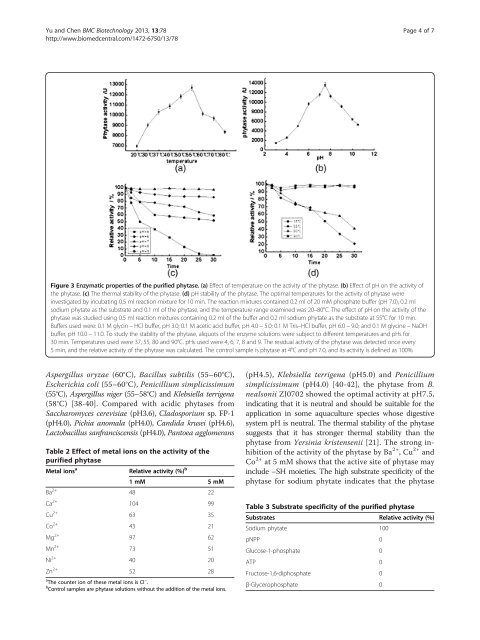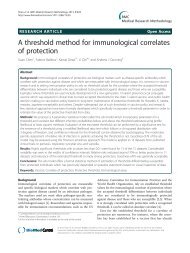Purification and characterization of a novel neutral and heat-tolerant ...
Purification and characterization of a novel neutral and heat-tolerant ...
Purification and characterization of a novel neutral and heat-tolerant ...
You also want an ePaper? Increase the reach of your titles
YUMPU automatically turns print PDFs into web optimized ePapers that Google loves.
Yu <strong>and</strong> Chen BMC Biotechnology 2013, 13:78 Page 4 <strong>of</strong> 7<br />
http://www.biomedcentral.com/1472-6750/13/78<br />
Figure 3 Enzymatic properties <strong>of</strong> the purified phytase. (a) Effect <strong>of</strong> temperature on the activity <strong>of</strong> the phytase. (b) Effect <strong>of</strong> pH on the activity <strong>of</strong><br />
the phytase. (c) The thermal stability <strong>of</strong> the phytase. (d) pH stability <strong>of</strong> the phytase. The optimal temperatures for the activity <strong>of</strong> phytase were<br />
investigated by incubating 0.5 ml reaction mixture for 10 min. The reaction mixtures contained 0.2 ml <strong>of</strong> 20 mM phosphate buffer (pH 7.0), 0.2 ml<br />
sodium phytate as the substrate <strong>and</strong> 0.1 ml <strong>of</strong> the phytase, <strong>and</strong> the temperature range examined was 20–80°C. The effect <strong>of</strong> pH on the activity <strong>of</strong> the<br />
phytase was studied using 0.5 ml reaction mixtures containing 0.2 ml <strong>of</strong> the buffer <strong>and</strong> 0.2 ml sodium phytate as the substrate at 55°C for 10 min.<br />
Buffers used were: 0.1 M glycin − HCl buffer, pH 3.0; 0.1 M acetic acid buffer, pH 4.0 − 5.0; 0.1 M Tris–HCl buffer, pH 6.0 − 9.0; <strong>and</strong> 0.1 M glycine − NaOH<br />
buffer, pH 10.0 − 11.0. To study the stability <strong>of</strong> the phytase, aliquots <strong>of</strong> the enzyme solutions were subject to different temperatures <strong>and</strong> pHs for<br />
30 min. Temperatures used were 37, 55, 80 <strong>and</strong> 90°C. pHs used were 4, 6, 7, 8 <strong>and</strong> 9. The residual activity <strong>of</strong> the phytase was detected once every<br />
5 min, <strong>and</strong> the relative activity <strong>of</strong> the phytase was calculated. The control sample is phytase at 4°C <strong>and</strong> pH 7.0, <strong>and</strong> its activity is defined as 100%.<br />
Aspergillus oryzae (60°C), Bacillus subtilis (55–60°C),<br />
Escherichia coli (55–60°C), Penicillium simplicissimum<br />
(55°C), Aspergillus niger (55–58°C) <strong>and</strong> Klebsiella terrigena<br />
(58°C) [38-40]. Compared with acidic phytases from<br />
Saccharomyces cerevisiae (pH3.6), Cladosporium sp. FP-1<br />
(pH4.0), Pichia anomala (pH4.0), C<strong>and</strong>ida krusei (pH4.6),<br />
Lactobacillus sanfranciscensis (pH4.0), Pantoea agglomerans<br />
Table 2 Effect <strong>of</strong> metal ions on the activity <strong>of</strong> the<br />
purified phytase<br />
Metal ions a<br />
Relative activity (%) b<br />
1mM<br />
5mM<br />
Ba 2+ 48 22<br />
Ca 2+ 104 99<br />
Cu 2+ 63 35<br />
Co 2+ 43 21<br />
Mg 2+ 97 62<br />
Mn 2+ 73 51<br />
Ni 2+ 40 20<br />
Zn 2+ 52 28<br />
a The counter ion <strong>of</strong> these metal ions is Cl − .<br />
b Control samples are phytase solutions without the addition <strong>of</strong> the metal ions.<br />
(pH4.5), Klebsiella terrigena (pH5.0) <strong>and</strong> Penicillium<br />
simplicissimum (pH4.0) [40-42], the phytase from B.<br />
nealsonii ZJ0702 showed the optimal activity at pH7.5,<br />
indicating that it is <strong>neutral</strong> <strong>and</strong> should be suitable for the<br />
application in some aquaculture species whose digestive<br />
system pH is <strong>neutral</strong>. The thermal stability <strong>of</strong> the phytase<br />
suggests that it has stronger thermal stability than the<br />
phytase from Yersinia kristensenii [21]. The strong inhibition<strong>of</strong>theactivity<strong>of</strong>thephytasebyBa<br />
2+ ,Cu 2+ <strong>and</strong><br />
Co 2+ at 5 mM shows that the active site <strong>of</strong> phytase may<br />
include –SH moieties. The high substrate specificity <strong>of</strong> the<br />
phytase for sodium phytate indicates that the phytase<br />
Table 3 Substrate specificity <strong>of</strong> the purified phytase<br />
Substrates Relative activity (%)<br />
Sodium phytate 100<br />
pNPP 0<br />
Glucose-1-phosphate 0<br />
ATP 0<br />
Fructose-1,6-diphosphate 0<br />
β-Glycerophosphate 0
















